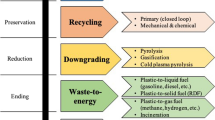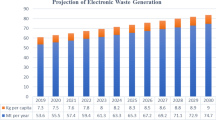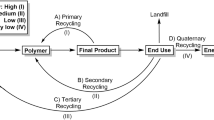Abstract
This article emphasizes on waste heat recovery for the implementation of organic Rankine cycle technology in the Indian industrial sector. A large proportion of energy is consumed by various industries, which leads to environmental pollution in multiple ways. Since the past few years, research is going on for re-using this low-grade waste energy utilizing organic Rankine cycle technology. In this report, a thorough review has been carried out to find the significant scope for recovering low-grade waste energy, primarily in cement, iron and steel and glass industries. Case studies based on the data collected from the associated plants have also been reported. A summary of different waste heat recovery cycles mechanism and working fluid selection procedure is also included. In the succeeding stage, various technological and legal aspects of using the recovered energy through power grid lines have been discussed. The review sketches a potential scope of using the low-grade waste energy in fulfilling the high energy demand of Indian commercial sector as well as domestic energy industry.









Source Ministry of Statistics and Programme Implementation, Energy Statistics 2013, Government of India


Source Adapted from Holcim (2012)

Similar content being viewed by others
Abbreviations
- ALT:
-
Atmospheric lifetime
- BEE:
-
Bureau of energy efficiency
- CHP:
-
Combined heat and power
- DCs:
-
Designated consumers
- DER:
-
Distributed energy resources
- GWP:
-
Global warming potential
- HRSG:
-
Heat recovery steam generator
- HCFC:
-
Hydrochlorofluorocarbon
- HFC:
-
Hydrofluorocarbon
- LGWH:
-
Low-grade waste heat
- LFL:
-
Lower flammability limit
- MST:
-
Maximum stability temperatures
- MSMEs:
-
Micro, small and medium enterprises
- NBP:
-
Normal boiling point
- NMEEE:
-
National mission for enhanced energy efficiency
- ORC:
-
Organic Rankine cycle
- OTEC:
-
Ocean thermal energy conversion
- ODP:
-
Ozone depletion potential
- RES:
-
Renewable energy sources
- TFC:
-
Trilateral flash cycle
- MRC:
-
Maloney and Robertson cycle
- TLV:
-
Threshold limit value
- VPP:
-
Virtual power plant
- WHR:
-
Waste heat recovery
- WHP:
-
Waste heat to power
- H:
-
Specific enthalpy
- P:
-
Absolute pressure
- Q in :
-
Heat input
- Q out :
-
Heat reject
- R:
-
Universal gas constant
- S:
-
Entropy
- T:
-
Temperature
- T C :
-
Critical temperature
- P C :
-
Critical pressure
- V:
-
Molar volume
- W net :
-
Net useful work
- η :
-
Efficiency
- ω :
-
Acentric factor of species
- ξ :
-
Slope of vapour saturation curve
References
ACEEE (2007) Industrial waste-heat recovery: benefits and recent advancements in technology and applications. http://aceee.org/files/proceedings/2007/data/papers/05_2_048.pdf. Accessed 20 June 2016
Acharjee P (2013) Strategy and implementation of Smart Grids in India. Energy Strategy Rev 1(3):193–204
Angelino G, Invernizzi C (2003) Experimental investigation on the thermal stability of some new zero ODP refrigerants. Int J Refrig 26:51–58
ASH (2016a) ASHRAE standards and guidelines. https://www.ashrae.org/standards-research–technology/standards–guidelines. Accessed 20 June 2016
ASH (2016b) Designation and safety classification of refrigerants. https://www.ashrae.org/File%20Library/docLib/Public/20080807_34m_thru_34v_final.pdf. Accessed 20 June 2016
ASME (2015) [Internet] Delft: third international seminar on ORC power systems 2015. http://www.asme-orc2015.be/. Accessed 19 June 2016
Badr O, Probert SD, O’callaghan PW (1985) Selecting a working fluid for a Rankine cycle engine. Appl Energy 21:1–42
Bakari K, Kling W (2010) Virtual power plants: an answer to increasing distributed generation. In: Innovative smart grid technologies conference Europe (ISGT Europe), IEEE PES, pp 1e6
Bakhtar F, Mashmoushy H, Jadayel OC (1997) On the performance of a cascade of turbine rotor tip section blading in wet steam. Part 4: droplet measurements. Proc Inst Mech Eng Part C: J Mech Eng Sci 211:639–648
Bao J, Zhao L (2013) A review of working fluid and expander selections for organic Rankine cycle. Renew Sustain Energy Rev 24:325–342
BEE (2016) PAT Booklet https://beeindia.gov.in/content/pat-3. Accessed 20 June 2016
Bombarda P, Ivernizzi CM, Pietra C (2009) Heat recovery from diesel engines: a thermodynamic comparison between Kalina and ORC cycles. Appl Therm Eng 30:212–219
Calderazzi L, Colonna di Paliano P (1997) Thermal stability of R-134a, R141b, R13I1, R7146, R125 associated with stainless steel as a containing material. Int J Refrig 20:381–389
Calm J, Hourahan G (2007) Refrigerant data update. HPAC Eng 79(January):50–64
CENS (2016) Per capita energy consumption in India. http://www.livemint.com/Industry/jqvJpYRpSNyldcuUlZrqQM/Indias-per-capita-electricity-consumption-touches-1010-kWh.html
CERCa (2016) Technical standards for connectivity to the grid, regulations. http://www.cercind.gov.in/other_acts.html. Accessed 25 June 2016
CERCb (2003) The electricity act, 2003. http://www.cercind.gov.in/Act-with-amendment.pdf. Accessed 25 June 2016
CERCc (2016) Tariff Policy http://www.powermin.nic.in/acts_notification/electricity_act2003/pdf/Amendment_Tariff_Policy.pdf
Chen H, Goswami DY, Stefanakos EK (2010) A review of thermodynamic cycles and working fluids for the conversion of low-grade heat. Renew Sustain Energy Rev 14(9):3059–3067
CMA (2016) India Cement Manufacturers Association of India http://www.cmaindia.org/activities/Publications-and-Periodicals.html. Accessed 20 June 2016
Corera J, Maire J (2009) Flexible Electricity networks to integrate the expected energy evolution, Fenix, Kassel, Germany. Tech, Rep
CSE (2009) Green Rating Project http://www.cseindia.org/content/efficient-real-time-pollution-monitoring-and-reporting-system-a-must-coal-energy-sector-cse. Accessed 20 June 2016
Date A, Alam F, Khaghani A, Akbarzadeh A (2012) Investigate the potential of using trilateral flash cycle for combined desalination and power generation integrated with salinity gradient solar ponds. Proc Eng 49:42–49
Demirkaya G, Besarati S, Padilla RV, Archibold AR, Goswami DY, Rahman MM, Stefanakos EL (2012) Multi-objective optimization of a combined power and cooling cycle for low-grade and midgrade heat sources. ASME J Energy Resour Technol 134(3):032002
Demuth OJ (1981) Analyses of mixed hydrocarbon binary thermodynamic cycles for moderate temperature geothermal resources, Idaho
Desai NB, Bandyopadhyay S (2009) Process integration of organic Rankine cycle. Energy 34:1674–1686
Desai NB, Bandyopadhyay S (2015) Integration of parabolic trough and linear Fresnel collectors for optimum design of concentrating solar thermal power plant. Clean Technol Environ Policy 17(7):1945–1961
Desai NB, Bandyopadhyay S (2016) Thermo-economic comparisons between solar steam Rankine and organic Rankine cycles. Appl Therm Eng
Desai NB, Bandyopadhyay S (2016b) Thermo-economic analysis and selection of working fluid for solar organic Rankine cycle. Appl Therm Eng 95:471–481
DiPippo R (2004) Second Law assessment of binary plants generating power from low temperature geothermal plants. Geothermics 33:565–586
EXE (2016) List of installed ORC system. http://www.exergy-orc.com/references/installations. Accessed 20 June 2016
Fabris G (2006) Two phase flow turbine for cogeneration, geothermal, solar and other applications. FAS Eng
Galanis N, Cayer E, Roy P, Denis ES, Desilets M (2009) Electricity generation from low temperature sources. J Appl Fluid Mech 2:55–67
Giovani Gutierrez-Arriaga C, Abdelhady F, Bamufleh HS, Serna-Gonzalez M, El-Halwagi MM, Maria Ponce-Ortega J (2015) Industrial waste heat recovery and cogeneration involving organic Rankine cycles. Clean Technol Environ Policy 17(3):767–779
GIZ (2013) Indo-German Energy Programme (IGEN) https://www.giz.de/en/worldwide/15767.html. Accessed 20 June 2016
GIZ (2016) Indo-German energy forum support office. https://www.giz.de/en/worldwide/15850.html. Accessed 20 June 2016
GNR (2013) Development of the GNR Database https://www.iea.org/media/workshops/2014/industryreviewworkshopoct/9_IEA_CO2Protocol_2014_10_30_sent.pdf. Accessed 20 June 2016
Goswami DY, Xu F (1999) Analysis of a new thermodynamic cycle for combined power and cooling using: low and mid temperature solar collectors. ASME J Sol Energy Eng 121(2):91–97
Goswami DY, Hingorani S, Mines G (1991) A laser-based technique for particle sizing to study two-phase expansion in turbines. J Solar Energy Eng 113:211–218
Han SJ, Lin HM, Chao KC (1988) Vapour-liquid equilibrium of molecular fluid mixtures by equation of state. Chem Eng Sci 43:2327–2367
Harstad KG, Miller RS, Bellan J (1997) Efficient high-pressure state equations. AIChE J 43:1605–1610
Holcim (2012) Cement solutions http://www.lafargeholcim.com/cement-solutions. Accessed 20 June 2016
Hung TC, Shai TY, Wang SK (1997) A review of ORCs (ORCs) for the recovery of low-grade waste heat. Energy 22(7):661–667
Huppmann G (1984) Industrial WHR by use of ORCs (ORC), commission of the European communities (Report EUR 9236, 1, Dusseldorf), p 409
Ibrahim OM, Klein SA (1996) Absorption power cycles. Energy 21:21–27
IEA (2011) Energy transition for industry-India and the global context. www.iea.org/papers/2011/india_industry_transition_28feb11.pdf. Accessed 20 June 2016
IEC (2001) International electro technical commission wind turbine generator systems. Part 21. Measurement and assessment of power quality characteristics of grid connected wind turbines, IEC 61400-2
IEEE (2003) Application Guide for IEEE Std 1547. http://ieeexplore.ieee.org/xpl/articleDetails.jsp?arnumber=1225051&filter=AND(p_Publication_Number:8676). Accessed 20 June 2016
IEEE (2016) Standards code of IEEE. http://standards.ieee.org/findstds/3000stds/index.html. Accessed 19 June 2016
IEGC (2010) Indian electricity grid code. http://cercind.gov.in/2010/ORDER/February2010/IEGC_Review_Proposal.pdf. Accessed 19 June 2016
IGD (2016) Publication of Indian Glass Directory 2016 http://www.aigmf.com/glass-directory.php. Accessed 20 June 2016
IGEF (2014) Indo-German energy symposium. http://energyforum.in/publication-show/items/india-energy-outlook_weo2015.html. Accessed 20 June 2016
Kalina AI (1984) Generation of energy. US Patent No 405942
Karimi MN, Dutta A, Kaushik A, Bansal H, Haque SZ (2016) A review of organic Rankine. Kalina Goswami Cycle 3(January):90–105
Krishna Priya GS, Bandyopadhyay S (2013) Emission constrained power system planning: a pinch analysis based study of Indian electricity sector. Clean Technol Environ Policy 15:771–782
Kumar KA, Sundareswaran K, Venkateswaran PR (2014) Performance study on a grid connected 20kWp solar photovoltaic installation in an industry in Tiruchirappalli (India). Energy Sustain Dev 23:294–304
Lee MJ, Tien DL, Shao CT (1993) Thermophysical capability of ozone-safe working fluids for an ORC system. Heat Recovery Syst CHP 13:409–418
Liu B, Chien K, Wang C (2004) Effect of working fluids on ORC for waste heat recovery. Energy 29:1207–1217
Maizza V, Maizza A (1996) Working fluids in non-steady flows for waste energy recovery systems. Appl Therm Eng 16:579–590
Marechal FO, Favrat D, Jochem E (2005) Energy in the perspective of the sustainable development: the 2000 W society challenge. Resour Conserv Recycl 44:245–262
Minea V (2014) Power generation with ORC machines using low-grade waste heat or renewable energy. Appl Therm Eng 69(1–2):143–154
Mlcak HA (2002) Kalina cycle concepts for low temperature geothermal. Geotherm Resour Council Trans 26:707–714
MNRE (2016) Indian renewable energy scenario. http://mnre.gov.in/file-manager/annual-report/2015-2016/EN/Chapter%201/chapter_1.htm#2. Accessed 20 June 2016
Mohammed MA, Khatita TS, Ashour FH, Ismail IM (2013) Power generation using WHR by ORC in oil and gas sector in Egypt: a case study. Energy 64:462–472
MOSP (2015) Energy statistics 2015. http://mospi.nic.in/Mospi_New/upload/Energy_stats_2015_26mar15.pdf. Accessed 20 June 2016
Narula K (2013) Renewable energy certificates (RECs) in India—a performance analysis and future outlook. Renew Sustain Energy Rev 27:654–663
Niggeman RE, Greenlee WJ, Lacey PD (1978) Fluid selection and optimization of an ORC waste heat power conversion system. ASME 78-WA/Ener-6
NSP (2012) Ministry of steel. National Steel Policy, New Delhi. http://steel.gov.in/06112012%20National%20Steel%20Policy%20Draft.pdf. Accessed 20 June 2016
Ogriseck S (2009) Integration of a Kalina cycle in a combined heat and power plant, a case study. Appl Therm Eng 29:2843–2848
OPC (2016) List of installed ORC system. http://opconenergysystem.com/en/about-oes/history. Accessed 20 June 2016
Padilla RV, Archibold AR, Demirkaya G, Besarati S, Goswami DY, Rahman MM, Stefanakos EL (2012) Performance analysis of a rankine cycle integrated with the goswami combined power and cooling cycle. ASME J Energy Resour Technol 134(3):032001
PC (2011) Report of the working group on steel industry for the twelfth five year plan. Planning Commission, New Delhi. http://planningcommission.nic.in/reports/genrep/ar_eng1112.pdf. Accessed 20 June 2016
Peng D-Y, Robinson DB (1977) A rigorous method for predicting the critical properties of multicomponent systems from an equation of state. AIChE J 23:137–144
Poling B, Prausnitz J, Connell JO (2000) The properties of gases and liquids. McGraw-Hill Professional, New york
Pouraghaie M, Atashkari K, Besarati SM, Nariman-zadeh N (2010) Thermodynamic performance optimization of a combined power/cooling cycle. Energy Conv Manag 51:204–211
Quoilin S, Van Den Broek M, Declaye S, Dewallef P, Lemort V (2013) Techno-economic survey of organic rankine cycle (ORC) systems. Renew Sustain Energy Rev 22:168–186
Sandrameli SM, Goswami DY (2007) Optimum operating conditions for a combined power and cooling thermodynamic cycle. Appl Therm Eng 84:254–265
Sarkar J, Bhattacharyya S (2015) Potential of organic Rankine cycle technology in India: working fluid selection and feasibility study. Energy 90:1618–1625
Schuster A, Karellas S, Kakaras E, Spliethoff H (2009) Energetic and economic investigation of organic Rankine cycle applications. Appl Therm Eng 29(8–9):1809–1817
Shrimali G, Tirumalachetty S (2013) Renewable energy certificate markets in India—a review. Renew Sustain Energy Rev 26:702–716
Smith IK (1994) Development of the trilateral flash cycle system. In: Proceedings of the Institution of Mechanical Engineers
Smith IK, Stosic N (2001a) Prospects for energy conversion efficiency improvements by the use of twin screw two-phase expanders. In: Proceedings of the 2nd international heat powered cycles conference, Paris
Smith IK, Stosic N, Kovacevic A (2001b) Power recovery from low cost two-phase expanders. GRC Annual Meeting, San Diego
Smith IK, Stosic N, Kovacevic A (2005) Screw expanders increase output and decrease the cost of geothermal binary power plant systems. In: Proceedings of the geothermal resources council annual meeting, Reno 25–28 Sept
Stine WB, Geyer M (2001) Power cycles for electricity generation. In: Power from the sun. http://www.powerfromthesun.net/Book/chapter12/chapter12.html. Accessed June 2016
Sundaram S, Babu JSC (2015) Performance evaluation and validation of 5MWp grid connected solar photovoltaic plant in South India. Energy Convers Manag 100:429–439
Takeuchi Y, Shiomi H, Miyamae N, Hiramatsu M, Mistuto M, Iwao Ohshima I, (1999) Feasibility study for application of mixture working fluid cycle to nuclear reactor power plant. In: Proceedings of 7th international conference on nuclear engineering, pp 1–8. Tokyo, 19–23 Apr 1999
Tchanche BF, Papadakis G, Lambrinos G, Frangoudakis A (2010a) Low-grade heat conversion into power using ORCs—a review of various applications. Renew Energy 15:3963–3979
Tchanche BF, Quoilin S, Declaye S, Papadakis G, Lemort V (2010) Economic optimization of small scale organic Rankine cycles. In: Proceedings of 23rd international conference on efficiency, cost, optimization, simulation and environmental impact of energy systems (ECOS), Lausane, 14–17 June 2010
Thakur J, Chakraborty B (2015) Intelli-grid: moving towards automation of electric grid in India. Renew Sustain Energy Rev 42(2015):16–25
TRI (2016) List of installed ORC system. http://www.triogen.nl/references/reference-overview. Accessed 20 June 2016
TUR (2016) List of installed ORC system. http://www.turboden.eu/en/references/references-map.php. Accessed 20 June 2016
Uehara H (2006) History and the future of OTEC. In: Proceedings of renewable energy 2010 Japan
Uehara H, Ikegami Y, Nishida T (1994) Performance analysis of OTEC using new cycle with absorption and extraction process. In: Proceedings of oceanology international, vol. 6
Uehara H, Ikegami Y, Nishida T, Kikuchi S, Tsuboi K (1997) OTEC system using Uehara cycle. In: Proceedings of the international OTEC/DOWA association conference
UNFCCC (2015) Waste heat recovery from stoves of Blast Furnace-3 of Visakhapatnam Steel Plant https://cdm.unfccc.int/Projects/DB/BVQI1408632203.99/view. Accessed 20 June 2016
Urpelainen J (2014) Grid and off-grid electrification: an integrated model with applications to India. Energy Sustain Dev 19:66–71
Verbruggen A (2008) Renewable and nuclear power: a common future. Energy Policy 36:4036–4047
Vidhi R, Kuravi S, Goswami DY, Stfanakos E, Sabau AS (2013) Organic fluids in a supercritical rankine cycle for low temperature power generation. ASME J Energy Resour Technol 135:042002
Vijayaraghavan S (2003) Thermodynamic studies on alternate binary working fluid combinations and configurations for a combined power and cooling cycle. Ph.D. Thesis, University of Florida
Wali E (1980) Working fluids for solar Rankine-cycle cooling systems. Energy 5:631–639
Wang XX, Zou HW (2007) Current situation and prospect of liquid slag sensible heat recovery technology. Ferro Alloy 5:34–36
Xu F, Goswami DY, Bhagwat SS (2000) A combined power/cooling cycle. Energy 25:233–246
Yamamoto T, Furuhata T, Arai N, Mori K (2001) Design and testing of the ORC. Energy 26:239–251
Zhao Y, Akbarzadeh A, Andrews J (2007) Combined water desalination and power generation using a salinity gradient solar pond as a renewable energy source in ISES World Congress. Springer, Berlin, Heidelberg
Author information
Authors and Affiliations
Corresponding author
Rights and permissions
About this article
Cite this article
Saha, B.K., Chakraborty, B. Utilization of low-grade waste heat-to-energy technologies and policy in Indian industrial sector: a review. Clean Techn Environ Policy 19, 327–347 (2017). https://doi.org/10.1007/s10098-016-1248-2
Received:
Accepted:
Published:
Issue Date:
DOI: https://doi.org/10.1007/s10098-016-1248-2




